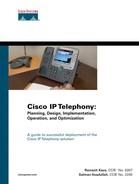IP telephony (IPT) technology has gained wide acceptance in the industry because it offers new ways to communicate and enables rich media communication capabilities. Recent studies have shown that deployment of IPT also helps improve employee productivity as a result of faster moves, adds, and changes; increased user mobility; and reduction in the time to set up telecommunication infrastructure for new office spaces. These are a few of the many benefits that are motivating organizations to move to IP-based PBX deployments.
Successful deployment of any new technology solution requires thorough understanding of the function of various components involved and the interaction among them. The architects and engineers who are tasked with implementing the IPT solution must ensure that the proposed architecture meets all the requirements and is also scalable in the future. To assist the architects and engineers in accomplishing this task, this book divides the deployment of IPT into planning, design, implementation, operation, and optimization (PDIOO) phases.
This book addresses the most important information that customers, network engineers, and architects should collect in each phase of the PDIOO methodology in deploying Cisco IPT solutions.
The goal of this book is to be a useful guide for network engineers and architects going through the various phases of planning and deploying a Cisco IPT solution. This book helps you to make the decisions that best suit a particular network scenario.
The major tasks involved in each phase of the PDIOO methodology are explained with the aid of a case study that includes the most commonly deployed Cisco IPT architectures, telephony features, and applications. You can use the questionnaires in the appendixes to collect details about the customer’s current network and to gather IPT requirements to propose the most suitable IPT network architecture and a detailed design.
To keep this book concise, in-depth discussion of communication protocols is not included because this information is readily available in other books and in Requests for Comments (RFCs).
The design principles and guidelines discussed in this book are applicable to Cisco CallManager version 3.3.3 and above. With the release of new versions of Cisco CallManager, you might find new features and scalability enhancements. However, the basic design rules and the PDIOO methodology remain the same.
This book is organized into three parts.
Part I, “Overview of Technology, Protocols, and the PDIOO Methodology,” discusses the VoIP and IPT technology and related protocols, mechanisms, architectures, and basics. It also lays the foundation of the PDIOO methodology and discusses why the PDIOO methodology is critical for successful IPT network implementation. Part I includes the following:
Part II, “Large-Scale IPT and Voice-Mail Network,” builds on the material discussed in Part I and provides a real-world example with technical details, examples, design tips, and configuration examples at each phase of the PDIOO methodology on how to build a successful and efficient large-scale IPT network from scratch. Part II includes the following:
Chapter 3, “Large-Scale Enterprise Requirements for IP Telephony”
Chapter 4, “Planning Phase”
Chapter 5, “Design Phase: Network Infrastructure Design”
Chapter 6, “Design of Call-Processing Infrastructure and Applications”
Chapter 7, “Voice-Mail System Design”
Chapter 8, “Implementation”
Chapter 9, “Operations and Optimization”
The final part includes eight appendixes that comprise questionnaires that enable you to collect the information that you need at different steps of the PDIOO methodology. This information is critical for a successful implementation of an IPT and voice-mail network. The appendixes are as follows:
Appendix B, “IPT Planning Phase: Network Infrastructure Analysis Questionnaire”
Appendix C, “IPT Planning Phase: Telecom Infrastructure Analysis Questionnaire”
Appendix D, “IPT Design Phase: IP Phone Selection Questionnaire”
Appendix E, “IPT Design Phase: IPT Requirement Analysis Questionnaire”
Appendix F, “Ordering T1/E1 PRI from the Carrier Questionnaire”
Appendix G, “Voice-Mail Design Questionnaire”
Appendix H, “IPT Implementation Checklist”
This book is organized logically with material advancing gradually. You can reference the various sections and chapters according to your needs and interests. If you have a good understanding of VoIP and IPT technology and tasks involved in PDIOO methodology, you might want to browse through Part I and spend more time on Part II. Part II references the appendix materials as appropriate, so you will have to refer to these appendixes quite often and will find them extremely useful.
This book provides several references and web links to useful material that is readily available and beyond the scope of this book.
